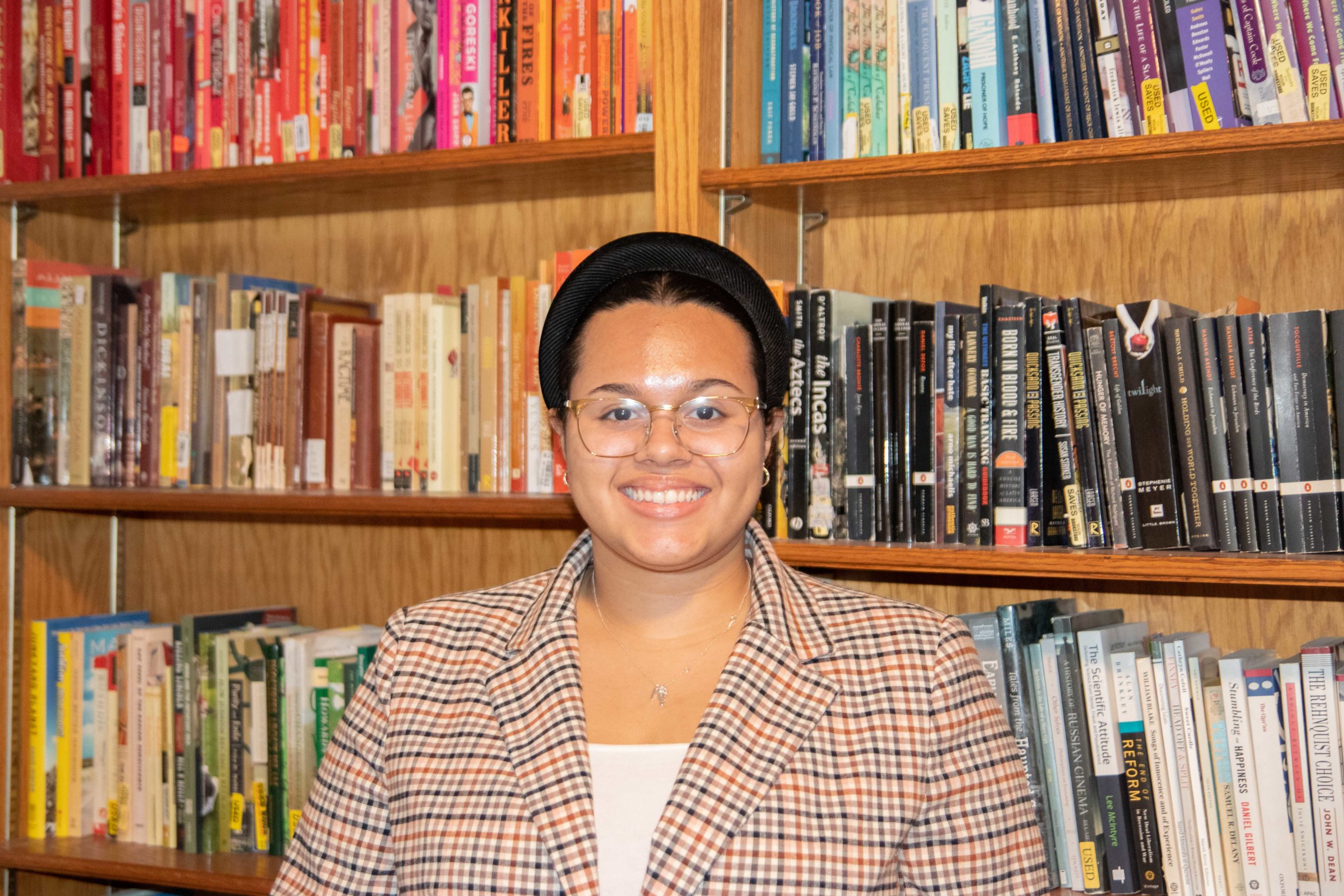Junior Meralis Álvarez-Morales began researching for her mini art exhibition Sacred Art of the Sea. Photo by Sarah Elise Navy.
At the beginning of fall term this academic year, junior Meralis Álvarez-Morales started research on her mini art exhibition, Sacred Art of the Sea, with no information on the artists and their work in relation to the Caribbean and Latin American art world. Now, after countless hours spent reading research articles, books, reddit threads, blogs and discussing with outside scholars and curators, Álvarez-Morales’ mini art exhibition showcases Haitian artists Seymour Étienne-Bottex, Florence Martinez and Jacques Enguerrand-Gourges, as well as an American artist, Karl Priebe. In terms of the art from these artists, Álvarez-Morales says, “The artworks by Haitian artists feature a variety of themes that focus on Haitian spirituality and religion, politics and most of all the representation of Haitianess.”
The process of building a historical art background for these unknown works was obviously full of both challenges and achievements. Álvarez-Morales began her research by reading the book Kafou recommended by Mieke Miller to “familiarize myself with Haitian history.” Álvarez-Morales does reveal, however, that many academic articles she read were not truthful with their delivery. “The biggest challenge was the art historical scholars, reviews and journals I would find written by U.S. American intellectuals often described Haitian art specifically, when discussing Caribbean art, as primitive and naive. Both of these terms, when used to discuss Haitian art, were used with negative connotations, often to imply that a nation of formerly enslaved and trafficked Afro-Caribbean people could not possibly produce prolific, genius and truly fabulous art and artists, when this is in fact not true.”
Throughout her research, Álvarez-Morales reveals she had to be creative with what resources she used, as she refused to use sources that actively spoke against and “diminished the importance of these works.” While compiling a historical background, Álvarez-Morales also realized “that as soon as Haiti achieved its independence in 1804, many aspiring nation-states quickly felt threatened by the possibility of a thriving Afro-Caribbean nation and have decidedly treated Haiti and its citizens in accordance with colonial notions and perceptions of Black native bodies.”
As a student focused on arts exchange and curatorial work, specifically within the Caribbean and Latin American art world, Álvarez-Morales’ work and research with Sacred Art of the Sea has changed her perspective. Álvarez-Morales says, “I am more dedicated than ever to building a career that will hopefully rewrite these narratives and restructure the museum and gallery space to be reflective of the space it claims to be; one in which every artists and every person can be seen, feel seen and learn. I am also even more aware of the dire need to decolonize, diversify and reexamine the art historical and global art fields of study.”
This mini art exhibition, however, has also had a personal impact on Álvarez-Morales, she reveals. “Being from the Caribbean myself, I have always been aware of how many Caribbean island nations and states are still treated as colonies, and the ways in which our stories, histories and people are written and seen very rarely reflect the people that are rooted in these lands,” Álvarez-Morales states. “I named this exhibition Sacred Art of the Sea because the stories of these island nations are sacred, and their preservation is crucial if we ever hope to truly understand the birth of the new world. I have also personally understood that my role in a museum, classroom or academic symposium should ensure that these are stories that are remembered in every way possible.”
Álvarez-Morales mentions that much of the feedback from her exhibition has been overwhelmingly positive. She plans to continue her work regarding arts exchange and curatorial work. “Thanks to the experiential learning fund and the Harrison award, I will be completing two research projects that focus on Puerto Rican art, museum spaces and galleries and the representation of the feminine body. I will be presenting this research in next years’ Harrison Symposium,” Álvarez-Morales says.
For those who would like to view Sacred Art of the Sea in person at the Wriston Art Galleries, contact Beth Zinsli at beth.a.zinsli@lawrence.edu to schedule an appointment.
Lastly, in regards to what she hopes viewers take away from her exhibition, Álvarez-Morales says, “It is my deepest wish that viewers understand that art in the Caribbean is not just a means to make money, but also a means to survive, celebrate […] a means to protect sacred knowledge, history and stories that have been buried or ‘forgotten’ by the world.

